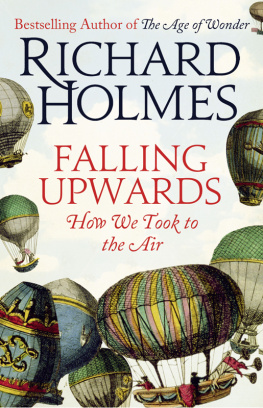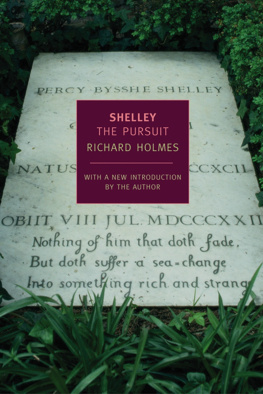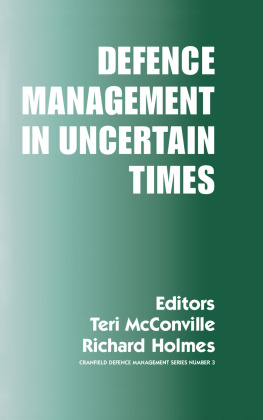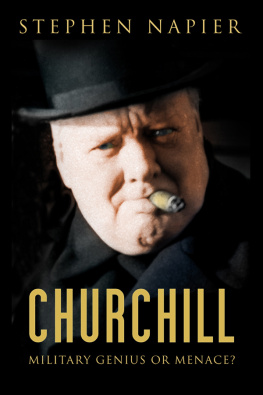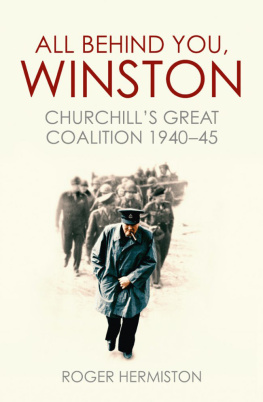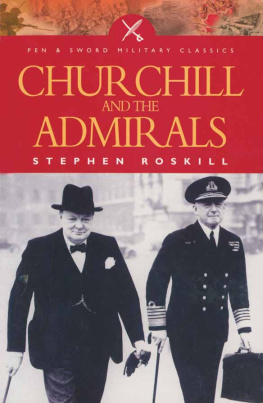A superb book Holmes vividly recaptures what it was like to work in Churchills bunker, the fabulous highs and dispiriting lows Observer
Holmes keeps things lively and colourful with his personal portraiture of Churchill the man, whose late-night ramblings and bedside briefings are all there Press Association
A worthy and evocative addition to the ever-growing mountain of Churchilliana Financial Times
Bright, because it illuminates the underground warren of sunless rooms where Churchills staff functioned below blackened London streets. Fascinating, because both the origins and the conditions of this subterranean headquarters, as well as Churchills presence in and absence from it, were not at all simple John Lukacs, author of Five Days in London
Loads of people will love this book it is imbued with Richard Holmess passion for the period Margaret Forster
Vivid and compelling Holmes brings to life a very British and surprisingly effective war-time government, and the improvised bunker in which it operated Professor Sir Lawrence Freedman
PROFESSOR RICHARD HOLMES is one of Britains most distinguished historians. He is Professor of Military and Security Studies at Cranfield University and the Defence Academy of the United Kingdom, and he has presented seven BBC TV series, including War Walks and In the Footsteps of Churchill.
Also by Richard Holmes
In order of publication
The English Civil War (with Brigadier Peter Young)
The Little Field Marshal: Sir John French
Soldiers (with John Keegan)
Firing Line
The Road to Sedan
Fatal Avenue
Riding the Retreat
War Walks
War Walks II
The Western Front
The Second World War in Photographs
The First World War in Photographs
Oxford Companion to Military History (general editor)
Battlefields of the Second World War
Redcoat: The British Soldier in the Age of Horse and Musket
Wellington: The Iron Duke
Tommy: The British Soldier on the Western Front, 19141918
In the Footsteps of Churchill
Sahib: The British Soldier in India
Dusty Warriors: Modern Soldiers at War
The World at War
Marlborough: Englands Fragile Genius
Shots from the Front
CHURCHILLS BUNKER
The Secret Headquarters at the Heart of Britains Victory
RICHARD HOLMES
in association with The Imperial War Museum


This paperback edition published in 2011
First published in Great Britain in 2009 by
PROFILE BOOKS LTD
3A Exmouth House
Pine Street
London EC1R 0JH
www.profilebooks.com
Copyright Richard Holmes, 2009, 2011
1 3 5 7 9 10 8 6 4 2
Typeset in Swift by MacGuru Ltd
info@macguru.org.uk
Printed and bound in Great Britain by
Bookmarque, Croydon, Surrey
The moral right of the author has been asserted.
All rights reserved. Without limiting the rights under
copyright reserved above, no part of this publication may
be reproduced, stored or introduced into a retrieval system,
or transmitted, in any form or by any means (electronic,
mechanical, photocopying, recording or otherwise), without
the prior written permission of both the copyright owner and
the publisher of this book.
A CIP catalogue record for this book is available from the
British Library.
ISBN 978 1 84668 231 5
eISBN 978 1 84765 198 3

CONTENTS

Plan of the Cabinet War Rooms basement, circa 1944


1 Admiralty
2 War Office
3 No. 10 Downing Street
4 Whitehall Gardens
5 Richmond Terrace
6 New Public Offices
7 Westminster Abbey
8 Houses of Parliament
9 Anson
10 Guards Chapel
11 Buckingham Palace
12 Horse Guards
FOREWORD
When Winston Churchill said that, in war, you have to run risks, one cannot help but wonder if he knew the degree of risk he ran in meeting in a poorly converted, poorly reinforced and poorly sited storage basement in Whitehall during the heaviest enemy bombing raids on London. Certainly, the few hundred people whose wartime lives were very largely spent in this secret complex felt secure there, even though, unbeknownst to them, the capacity of the War Rooms to withstand a direct hit was far from sure.
In the seventieth anniversary year of the site becoming operational a year that coincides with the twenty-fifth anniversary of the Rooms being opened up to the general public it is timely that the experience of those who worked so assiduously and deprived of daylight should be celebrated with a book that finally gives their story the prominence it deserves. And there could be no better choice of author than Professor Richard Holmes, one of the most inspired and original biographers of Sir Winston Churchill, and a writer whose works demonstrate an unparalleled understanding of the experience of the common man in war.
Richards in-depth book charts the discomforts, joys and quirks of daily and nightly life in the bunker, as well as giving the wider context of the war that raged above the heads of those living and working there. The history of the Rooms was shaped not only by their almost accidental origins as a temporary solution, but also by the actions of their chief resident and the personalities of those who surrounded him. It is through these stories that Richard outlines a strategic, human and occasionally comic history of this secret site, so important to the success of Britains war effort.
The Rooms post-war history has been no less accidental and colourful, and over the years the complex has evolved from a neglected monument to a prize-winning historic site operated by the internationally renowned Imperial War Museum. Decades after the last occupants surfaced into the wrecked streets of Central London, tens of thousands of tourists, school-children and Churchill aficionados yearly spelunk their way down to walk in the footsteps of the great man and his lesser-sung acolytes, receiving an intimate view of the Rooms and the lives of those who lived and worked in them.
Diane Lees
Director-General
Imperial War Museum
1
THE STORY BEHIND THE SECRET
The Second World War was supremely mobile. Armies and navies swirled, in their advances and retreats, over thousands of miles of land and sea, from the icy waters of the North Cape to the deserts of North Africa, and from Pacific atolls to the boundless Russian steppes. In sharp contrast, however, for the leaders of most combatant powers it was a war directed from static headquarters. The last days of Hitler were spent, famously, in his bunker in the heart of Berlin, but as early as 1940 he was forced to take refuge from British bombing in an underground shelter. The bombing of the home islands of Japan forced General Tojo and even the Emperor Hirohito into shelters long before the Japanese surrender. The Allies were very cautious about bombing Rome, where Mussolini had his headquarters in the fifteenth-century Palazzo Venezia, but even so the city was not immune from air attack. Only President Roosevelt and his advisers were wholly safe, for long-range bombers were, as yet, unable to reach Washington.
Next page

